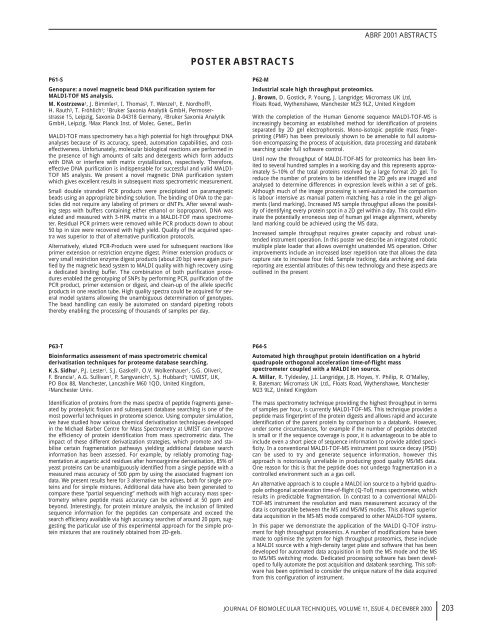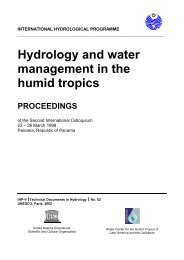FR AB - Science Reference
FR AB - Science Reference
FR AB - Science Reference
Create successful ePaper yourself
Turn your PDF publications into a flip-book with our unique Google optimized e-Paper software.
P61-S<br />
Genopure: a novel magnetic bead DNA purification system for<br />
MALDI-TOF MS analysis.<br />
M. Kostrzewa1, J. Bimmler2, I. Thomas2, T. Wenzel1, E. Nordhoff3, H. Rauth3, T. Fröhlich1; 1Bruker Saxonia Analytik GmbH, Permoserstrasse<br />
15, Leipzig, Saxonia D-04318 Germany, 2Bruker Saxonia Analytik<br />
GmbH, Leipzig, 3Max Planck Inst. of Molec. Genet., Berlin<br />
MALDI-TOF mass spectrometry has a high potential for high throughput DNA<br />
analyses because of its accuracy, speed, automation capabilities, and costeffectiveness.<br />
Unfortunately, molecular biological reactions are performed in<br />
the presence of high amounts of salts and detergents which form adducts<br />
with DNA or interfere with matrix crystallization, respectively. Therefore,<br />
effective DNA purification is indispensable for successful and valid MALDI-<br />
TOF MS analysis. We present a novel magnetic DNA purification system<br />
which gives excellent results in subsequent mass spectrometric measurement.<br />
Small double stranded PCR products were precipitated on paramagnetic<br />
beads using an appropriate binding solution. The binding of DNA to the particles<br />
did not require any labeling of primers or dNTPs. After several washing<br />
steps with buffers containing either ethanol or isopropanol, DNA was<br />
eluted and measured with 3-HPA matrix in a MALDI-TOF mass spectrometer.<br />
Residual PCR primers were removed while PCR products down to about<br />
50 bp in size were recovered with high yield. Quality of the acquired spectra<br />
was superior to that of alternative purification protocols.<br />
Alternatively, eluted PCR-Products were used for subsequent reactions like<br />
primer extension or restriction enzyme digest. Primer extension products or<br />
very small restriction enzyme digest products (about 20 bp) were again purified<br />
by the magnetic bead system to MALDI quality with high recovery using<br />
a dedicated binding buffer. The combination of both purification procedures<br />
enabled the genotyping of SNPs by performing PCR, purification of the<br />
PCR product, primer extension or digest, and clean-up of the allele specific<br />
products in one reaction tube. High quality spectra could be acquired for several<br />
model systems allowing the unambiguous determination of genotypes.<br />
The bead handling can easily be automated on standard pipetting robots<br />
thereby enabling the processing of thousands of samples per day.<br />
P63-T<br />
Bioinformatics assessment of mass spectrometric chemical<br />
derivatisation techniques for proteome database searching.<br />
K.S. Sidhu1, P.J. Lester1, S.J. Gaskell1, O.V. Wolkenhauer1, S.G. Oliver2, F. Brancia1, A.G. Sullivan1, P. Sangvanich1, S.J. Hubbard1; 1UMIST, UK,<br />
PO Box 88, Manchester, Lancashire M60 1QD, United Kingdom,<br />
2Manchester Univ.<br />
Identification of proteins from the mass spectra of peptide fragments generated<br />
by proteolytic fission and subsequent database searching is one of the<br />
most powerful techniques in proteome science. Using computer simulation,<br />
we have studied how various chemical derivatisation techniques developed<br />
in the Michael Barber Centre for Mass Spectrometry at UMIST can improve<br />
the efficiency of protein identification from mass spectrometric data. The<br />
impact of these different derivatization strategies, which promote and stabilise<br />
certain fragmentation pathways yielding additional database search<br />
information has been assessed. For example, by reliably promoting fragmentation<br />
at aspartic acid residues after homoarginine derivatisation, 85% of<br />
yeast proteins can be unambiguously identified from a single peptide with a<br />
measured mass accuracy of 500 ppm by using the associated fragment ion<br />
data. We present results here for 3 alternative techniques, both for single proteins<br />
and for simple mixtures. Additional data have also been generated to<br />
compare these “partial sequencing” methods with high accuracy mass spectrometry<br />
where peptide mass accuracy can be achieved at 50 ppm and<br />
beyond. Interestingly, for protein mixture analysis, the inclusion of limited<br />
sequence information for the peptides can compensate and exceed the<br />
search efficiency available via high accuracy searches of around 20 ppm, suggesting<br />
the particular use of this experimental approach for the simple protein<br />
mixtures that are routinely obtained from 2D-gels.<br />
POSTER <strong>AB</strong>STRACTS<br />
<strong>AB</strong>RF 2001 <strong>AB</strong>STRACTS<br />
P62-M<br />
Industrial scale high throughput proteomics.<br />
J. Brown, D. Gostick, P. Young, J. Langridge; Micromass UK Ltd,<br />
Floats Road, Wythenshawe, Manchester M23 9LZ, United Kingdom<br />
With the completion of the Human Genome sequence MALDI-TOF-MS is<br />
increasingly becoming an established method for identification of proteins<br />
separated by 2D gel electrophoresis. Mono-isotopic peptide mass fingerprinting<br />
(PMF) has been previously shown to be amenable to full automation<br />
encompassing the process of acquisition, data processing and databank<br />
searching under full software control.<br />
Until now the throughput of MALDI-TOF-MS for proteomics has been limited<br />
to several hundred samples in a working day and this represents approximately<br />
5–10% of the total proteins resolved by a large format 2D gel. To<br />
reduce the number of proteins to be identified the 2D gels are imaged and<br />
analysed to determine differences in expression levels within a set of gels.<br />
Although much of the image processing is semi-automated the comparison<br />
is labour intensive as manual pattern matching has a role in the gel alignments<br />
(land marking). Increased MS sample throughput allows the possibility<br />
of identifying every protein spot in a 2D gel within a day. This could eliminate<br />
the potentially erroneous step of human gel image alignment, whereby<br />
land marking could be achieved using the MS data.<br />
Increased sample throughput requires greater capacity and robust unattended<br />
instrument operation. In this poster we describe an integrated robotic<br />
multiple plate loader that allows overnight unattended MS operation. Other<br />
improvements include an increased laser repetition rate that allows the data<br />
capture rate to increase four fold. Sample tracking, data archiving and data<br />
reporting are essential attributes of this new technology and these aspects are<br />
outlined in the present<br />
P64-S<br />
Automated high throughput protein identification on a hybrid<br />
quadrupole orthogonal acceleration time-of-flight mass<br />
spectrometer coupled with a MALDI ion source.<br />
A. Millar, R. Tyldesley, J.I. Langridge, J.B. Hoyes, Y. Philip, R. O’Malley,<br />
R. Bateman; Micromass UK Ltd., Floats Road, Wythenshawe, Manchester<br />
M23 9LZ, United Kingdom<br />
The mass spectrometry technique providing the highest throughput in terms<br />
of samples per hour, is currently MALDI-TOF-MS. This technique provides a<br />
peptide mass fingerprint of the protein digests and allows rapid and accurate<br />
identification of the parent protein by comparison to a databank. However,<br />
under some circumstances, for example if the number of peptides detected<br />
is small or if the sequence coverage is poor, it is advantageous to be able to<br />
include even a short piece of sequence information to provide added specificity.<br />
In a conventional MALDI-TOF-MS instrument post source decay (PSD)<br />
can be used to try and generate sequence information, however this<br />
approach is notoriously unreliable in producing good quality MS/MS data.<br />
One reason for this is that the peptide does not undergo fragmentation in a<br />
controlled environment such as a gas cell.<br />
An alternative approach is to couple a MALDI ion source to a hybrid quadrupole<br />
orthogonal acceleration time-of-flight (Q-Tof) mass spectrometer, which<br />
results in predictable fragmentation. In contrast to a conventional MALDI-<br />
TOF-MS instrument the resolution and mass measurement accuracy of the<br />
data is comparable between the MS and MS/MS modes. This allows superior<br />
data acquisition in the MS-MS mode compared to other MALDI-TOF systems.<br />
In this paper we demonstrate the application of the MALDI Q-TOF instrument<br />
for high throughput proteomics. A number of modifications have been<br />
made to optimise the system for high throughput proteomics, these include<br />
a MALDI source with a high-density target plate and software that has been<br />
developed for automated data acquisition in both the MS mode and the MS<br />
to MS/MS switching mode. Dedicated processing software has been developed<br />
to fully automate the post acquisition and databank searching. This software<br />
has been optimised to consider the unique nature of the data acquired<br />
from this configuration of instrument.<br />
JOURNAL OF BIOMOLECULAR TECHNIQUES, VOLUME 11, ISSUE 4, DECEMBER 2000 203















